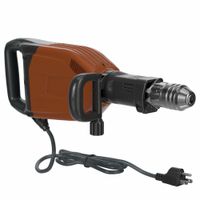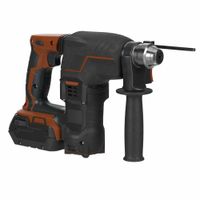Call +(254) 703 030 000 / 751 483 999 / 721 704 777
- Home
- Tools
- Power Tools
- Rotary Hammers Demolition Hammers Breaker Hammers
.....Read More
Frequently Asked Questions
What is the difference between a rotary hammer and a hammer drill?
A rotary hammer and a hammer drill are both power tools used for drilling into hard materials like concrete, brick, and stone, but they differ in mechanism, power, and applications.
A rotary hammer, also known as a rotary hammer drill, uses a piston mechanism to generate high-impact energy, making it more powerful and efficient for heavy-duty tasks. It has three modes: drill, hammer drill, and hammer only (chisel mode). This tool is ideal for large-scale construction projects, demolition, and drilling large holes in hard materials. Rotary hammers often feature an SDS (Slotted Drive System) chuck, which allows for quick bit changes and better energy transfer.
In contrast, a hammer drill, also known as a percussion drill, combines rotary motion with a hammering action. It uses a mechanical clutch to create a rapid hammering motion, which is less powerful than the piston mechanism of a rotary hammer. Hammer drills are suitable for lighter tasks, such as drilling into masonry or concrete for home improvement projects. They typically have two modes: drill and hammer drill. Hammer drills usually have a standard chuck, which can accommodate a variety of bit types.
In summary, the main differences lie in their power, mechanism, and intended use. Rotary hammers are more powerful, suitable for heavy-duty tasks, and have multiple modes, while hammer drills are less powerful, designed for lighter tasks, and have fewer modes.
How do rotary hammers work?
A rotary hammer, also known as a rotary hammer drill, is a power tool used for drilling and chiseling hard materials like concrete, stone, and masonry. It combines rotation with a hammering action to efficiently break through tough surfaces. Here's how it works:
1. **Motor and Gear System**: The rotary hammer is powered by an electric motor, which drives a crank mechanism. This mechanism converts the motor's rotational energy into a reciprocating motion.
2. **Piston and Air Pressure**: The crank mechanism moves a piston back and forth inside a cylinder. As the piston moves forward, it compresses air in the cylinder, creating high pressure.
3. **Hammering Action**: The compressed air propels a hammer mechanism, often a metal rod or striker, towards the drill bit. This delivers a powerful impact force to the bit, enabling it to break through hard materials.
4. **Rotational Motion**: Simultaneously, the motor's rotation is transferred to the drill bit through a series of gears. This rotation, combined with the hammering action, allows the bit to both drill and pulverize the material.
5. **Bit and Chuck System**: Rotary hammers use special bits with a shank design that fits into a chuck system, typically SDS (Slotted Drive System). This design allows the bit to move back and forth freely while being securely held in place.
6. **Modes of Operation**: Most rotary hammers have multiple modes: drilling only, hammering only, and a combination of both. This versatility allows them to be used for various tasks, from simple drilling to heavy-duty demolition.
By combining these elements, rotary hammers provide efficient and effective drilling and chiseling capabilities, making them essential tools in construction and renovation projects.
What are the best uses for a demolition hammer?
A demolition hammer is a powerful tool designed for heavy-duty tasks, primarily used in construction and renovation projects. Its best uses include:
1. **Concrete Breaking**: Demolition hammers are ideal for breaking up concrete slabs, driveways, and sidewalks. Their high impact force makes them efficient for removing old concrete structures.
2. **Masonry Work**: They are effective in demolishing brick walls, stone structures, and other masonry work, allowing for quick removal and renovation.
3. **Tile Removal**: These hammers can efficiently remove floor and wall tiles, making them useful for bathroom and kitchen renovations.
4. **Asphalt Breaking**: Demolition hammers are used to break up asphalt surfaces, such as roads and parking lots, for repair or replacement.
5. **Foundation Work**: They assist in breaking through foundations and footings, facilitating the installation of new structures or utilities.
6. **Chipping and Chiseling**: With appropriate attachments, demolition hammers can chip away at surfaces, making them useful for detailed demolition work.
7. **Removing Old Structures**: They are used to dismantle old structures, such as sheds or garages, by breaking down the materials into manageable pieces.
8. **Excavation**: In landscaping, demolition hammers can help in digging through hard soil or rock, aiding in the installation of new features like pools or ponds.
9. **Metal Cutting**: With the right attachments, they can cut through metal reinforcements in concrete, such as rebar, during demolition.
10. **Industrial Applications**: In industrial settings, they are used for dismantling machinery or breaking down large metal structures.
Overall, demolition hammers are versatile tools essential for any project requiring the removal or breaking down of hard materials.
How do I choose between a rotary hammer and a demolition hammer?
To choose between a rotary hammer and a demolition hammer, consider the following factors:
1. **Purpose**:
- **Rotary Hammer**: Ideal for drilling holes in hard materials like concrete, stone, and masonry. It combines rotation with a hammering action, making it suitable for tasks like installing anchors or rebar.
- **Demolition Hammer**: Designed for breaking and chipping concrete, asphalt, or masonry. It delivers powerful blows without rotation, making it perfect for demolition tasks.
2. **Power and Impact**:
- **Rotary Hammer**: Offers moderate impact energy, suitable for drilling and light chiseling. It often has multiple modes (drill, hammer drill, and chisel) for versatility.
- **Demolition Hammer**: Provides higher impact energy, focusing on delivering powerful blows for breaking and demolition work.
3. **Weight and Handling**:
- **Rotary Hammer**: Generally lighter and more versatile, allowing for overhead and precise work.
- **Demolition Hammer**: Heavier and bulkier, designed for ground-level or horizontal demolition tasks.
4. **Tool Holder**:
- **Rotary Hammer**: Typically uses SDS-plus or SDS-max bits, allowing for quick bit changes and secure holding.
- **Demolition Hammer**: Often uses hex shank or SDS-max chisels for heavy-duty applications.
5. **Frequency of Use**:
- **Rotary Hammer**: Suitable for regular use in construction or renovation projects where drilling and light chiseling are needed.
- **Demolition Hammer**: Best for occasional use in heavy demolition tasks due to its specialized function.
6. **Budget**:
- Consider the cost relative to the frequency and type of work. Rotary hammers are generally more versatile and may offer better value for varied tasks.
Choose based on the specific tasks you need to accomplish, considering the tool's capabilities and your project requirements.
What is an SDS drill?
An SDS (Slotted Drive System) drill is a type of power drill that is specifically designed for heavy-duty drilling tasks, particularly in hard materials like concrete, brick, and stone. The SDS system was developed by Bosch in 1975 and has become a standard for professional-grade rotary hammers and hammer drills.
The key feature of an SDS drill is its unique chuck system, which allows for quick and tool-free bit changes. The drill bits used in SDS drills have slots or grooves along the shank that fit into the chuck, allowing the bit to move back and forth while rotating. This design provides a more secure grip on the bit and enables efficient transmission of the hammering action, making it ideal for drilling into tough materials.
There are several types of SDS drills, including SDS-Plus and SDS-Max, which differ mainly in the size and power of the tool. SDS-Plus drills are suitable for lighter tasks and have a smaller shank diameter, while SDS-Max drills are used for more demanding applications and have a larger shank diameter, providing more power and impact energy.
SDS drills typically offer three modes of operation: rotary only, hammer only, and rotary hammer. The rotary only mode is used for standard drilling tasks, the hammer only mode is used for chiseling or demolition work, and the rotary hammer mode combines both actions for efficient drilling in masonry and concrete.
Overall, SDS drills are favored by professionals in construction and renovation for their durability, power, and versatility in handling tough drilling tasks.
How much impact energy do breaker hammers produce?
Breaker hammers, also known as demolition hammers, produce impact energy typically measured in joules (J) or foot-pounds (ft-lbs). The impact energy of a breaker hammer is a critical factor in determining its efficiency and suitability for various demolition tasks.
The impact energy of breaker hammers can vary significantly depending on the model and type. Smaller, handheld electric breaker hammers might produce impact energy in the range of 5 to 30 joules (approximately 3.7 to 22.1 ft-lbs). These are suitable for lighter tasks such as breaking up small concrete slabs or tiles.
Medium-sized breaker hammers, often used for more demanding tasks, can deliver impact energy ranging from 30 to 60 joules (22.1 to 44.3 ft-lbs). These are typically used for breaking up thicker concrete slabs, asphalt, or masonry.
Larger, more powerful breaker hammers, which can be pneumatic or hydraulic, are used for heavy-duty demolition work. These can produce impact energy exceeding 60 joules, with some models reaching up to 100 joules (73.8 ft-lbs) or more. These are ideal for breaking through reinforced concrete, rock, and other tough materials.
The choice of breaker hammer and its impact energy should align with the specific requirements of the job, considering factors such as the material's hardness, thickness, and the desired speed of demolition. Higher impact energy generally translates to faster and more efficient breaking, but it also requires more power and can lead to increased wear on the tool and operator fatigue.
What safety precautions should be taken when using a rotary or demolition hammer?
1. **Personal Protective Equipment (PPE):** Wear safety goggles to protect eyes from flying debris, ear protection to guard against noise, dust masks or respirators to avoid inhaling dust, and gloves to enhance grip and protect hands.
2. **Proper Clothing:** Wear long sleeves and pants to protect skin from debris. Avoid loose clothing or jewelry that could get caught in the tool.
3. **Tool Inspection:** Before use, inspect the hammer for any damage or wear, ensuring all parts are secure and functioning properly.
4. **Work Area Safety:** Clear the area of unnecessary objects and ensure adequate lighting. Keep bystanders at a safe distance.
5. **Secure Workpiece:** Ensure the material being worked on is stable and secure to prevent movement during operation.
6. **Correct Bit Usage:** Use the appropriate bit for the material and task. Ensure it is sharp and properly installed.
7. **Grip and Stance:** Maintain a firm grip and balanced stance to control the tool effectively and reduce the risk of injury from kickback.
8. **Electrical Safety:** If using an electric model, check for damaged cords and avoid wet conditions to prevent electric shock.
9. **Ventilation:** Ensure proper ventilation in enclosed spaces to avoid dust accumulation and inhalation.
10. **Tool Operation:** Follow the manufacturer’s instructions for operation. Do not force the tool; let it do the work.
11. **Rest Periods:** Take regular breaks to prevent fatigue, which can lead to accidents.
12. **Emergency Procedures:** Be familiar with emergency shut-off procedures and have a first aid kit readily available.
13. **Training:** Ensure all users are properly trained in the tool’s operation and safety procedures.



